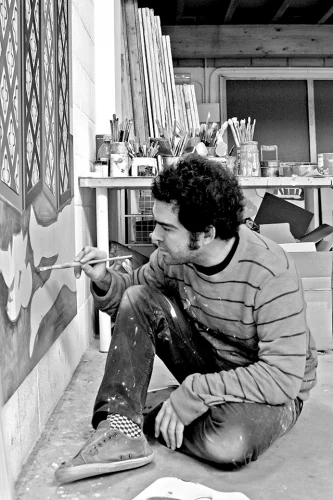For the Spanish painter Juan De La Rica, painting boils down to one thing : having fun while painting and exploring painting as a medium.
“To handle colors and lines, isn’t it a true diplomacy, as the real difficulty is precisely to harmonize all that.”
Raoul Dufy
Established in Bilbao and graduated in Fine Arts from the Basque Country University, Juan De La Rica explains “I like the idea that looking at a painting, the first impression is that it seems easy, but then one realize how complex it is.”
His paintings with saturated and striking color areas revisit with humor, and sometimes a hint of irony, a myriad of subjects, ranging from portraits to still lifes, including large religious paintings. The synthetic and precise line asserts a great technical mastery of the medium used, oil painting, and a keen sense of perspective and volume through expressive and stylized compositions.
The repertoire of themes in which the Basque painter draws allows him to interrogate painting both as a tool and as a picture per se. If you ask him about his favorite subject, he easily answers that every motif remains an option. The seeming simplicity of his works reflects a desire to analyze technical effects on iconographic archetypes, but also to alter and modernize them. The portraitist is portrayed in El Retratista, and saint Paul is laying on the ground in La conversión de San Pablo, much less gloriously than the Caravage’s saint Paul in his work of the same title. In both paintings, the main subject however remains a plot excuse for the painter to develop his technique : no matter the motif, lines and colors arrangements are aesthetically coherent.
Juan De La Rica’s inspirations
Juan De La Rica draws his inspiration in a large iconographic repertoire. If the composition problems reflect the Italian painters from the Quattrocento – he likes to quote Piero della Francesca or Giotto – his work also refers to the Basque School of painting of the first half of the XXth century. This regional movement, whose representative are the Zubiaurre brothers or Ramiro Arrue among others, is interested in the representation of the Basque folklore, that we find in the physiognomy of Juan De La Rica’s characters, or in the chosen themes, such as the portrait of Koldo. He combines this traditional pictorial style with the comics aesthetic, or even to American Pop Art, which is reflected in the large colorful areas. In addition to being inspired by Italian Masters, the painter also draws from a more contemporary corpus of references : film and comics stills, internet found images, and in a more intimate and personal way, pictures from his own family album.
The technique
This imagery, accessible to everyone, is simplified and aestheticized thanks to admirable technical solutions and a vibrant color palette. It is no coincidence that the superposition of motifs evoke collage : Juan De La Rica likes to start working by a digital superposition of images, which he then paints on the canvas with oil painting. The painter has not been using this technique for a long time, and it represents a challenge in itself. Oil painting, in contrast to gouache or acrylic, needs a long drying time, but the artist learnt to work with this difficulty. He paints alla prima, a creative process invented by Italian Renaissance painters that consists in painting in a single stroke, by layering colors without waiting for the successives layers to be fully dry. This complex technique allows a great expressivity and was especially favored by the Impressionists and the Ecole de Barbizon for the spontaneity and the rapidity of movement, that provides the spectator with a colored visual impression than realistic shapes.
Juan De La Rica manages to master this artistic method that allows him to “express himself and communicate ideas that cannot be expressed with words”. The result is splendid, the colors are shimmering, the form is synthetic and the line pure, offering an open narrative and a space for free interpretation to the watcher.
Inès Molière
